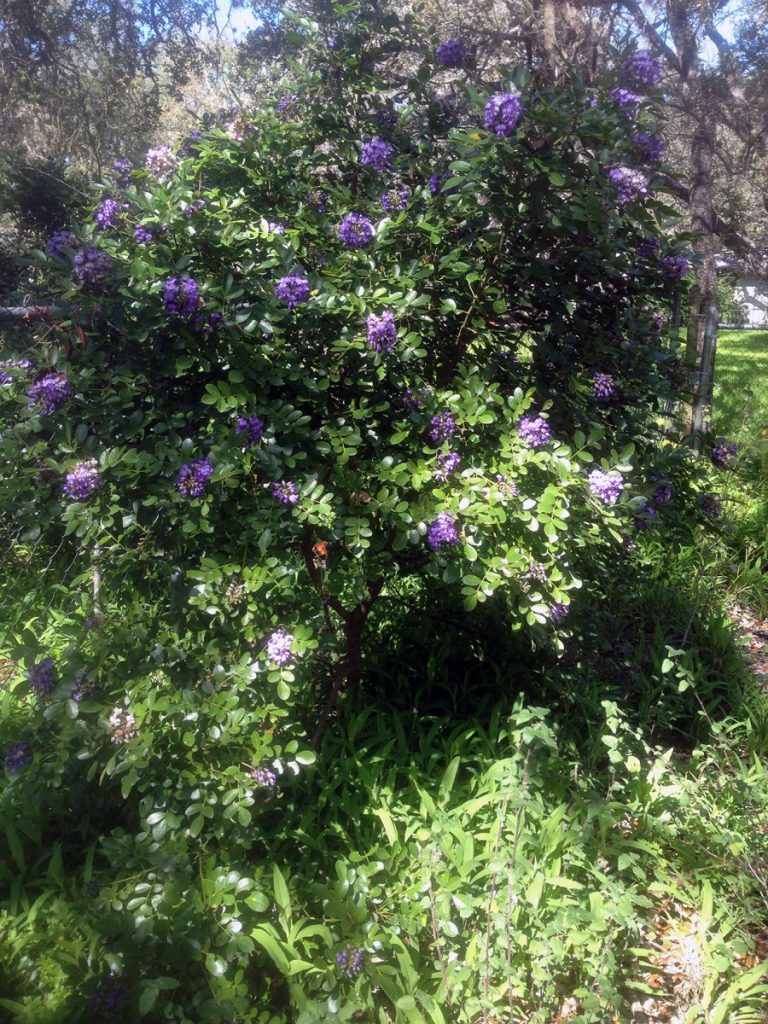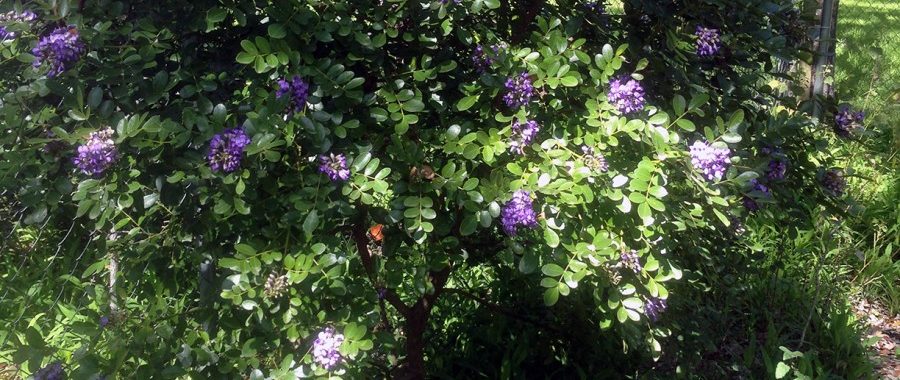Trail Notes: Mountain Laurels Galore
 “It smells . . . (long pause) . . . purple,” our daughter proclaimed the first time she encountered a mountain laurel in bloom. I’d not heard a better description of that scent before, nor in the many years since. This spring, her pronouncement has seemed particularly apropos. Purple has been in the air thicker than ever before—or so it would appear.
“It smells . . . (long pause) . . . purple,” our daughter proclaimed the first time she encountered a mountain laurel in bloom. I’d not heard a better description of that scent before, nor in the many years since. This spring, her pronouncement has seemed particularly apropos. Purple has been in the air thicker than ever before—or so it would appear.
I can’t say how many mountain laurels we have on the not-quite-an-acre property where we live, but the number is probably staggering. Right around the house, in the part of our place that I tend, I can count at least 20 good-sized trees, each of which has one or more seedling or small tree. And in the woods, there are even more—so many that I can’t begin to count them.
When all these trees are blooming, which was seemingly the case this year—the air is intoxicating with the scent of purple. Which raises a simple question: Why?
Not having an answer, I raised the issue with a Facebook group I belong to. I had almost 30 responses, most of which made perfect sense to me. I’ll share a few of those here:
- “Mine flowers or doesn’t mostly based on whether the buds held up. They produce the next year’s buds after flowering, so they have to hold up a whole year without somehow falling off, which usually seems related to particularly hard freezes, like below 13° or so.”
- “Last year the snowstorm killed all the buds and caused the plants to grow more branches. This year, more branches meant more blooms!”
- “Many mountain laurels didn’t bloom much or didn’t bloom at all last spring after the terrible February freeze. So, since they didn’t expend all that energy blooming and fruiting last year, they came into this spring with more energy to bloom and fruit…”
- “I don’t know if this is true, but it seems to me that the stress of drought or freeze can cause trees (or other plants) to go a bit overboard the next year trying to reproduce. Does anyone remember the full trashcans of acorns in 2012 after the 2011 drought?”
- “I’m seeing all sorts of plants go gangbusters this year – starting with the Ashe junipers pollinating all the way through February (I’ve never observed them to go past the end of January). Plants will reproduce in abundance following a major disturbance.”
- “Chill hours being certain lengths often make fruit trees produce better. So maybe it helps mountain laurels bloom more.”
- “It appears to me that so many plants will flourish one year then have a smaller showing the following year. Perhaps it has to do with expending energy which weakens them for the next season. The very cold winter two years ago set back many plants, last year they were recovering and this year many are having a glorious year, even in spite of the drought.”
- “The freeze killed all the blooms last year.”
- “Probably because of the cold winters. They needed the true dormancy.”
Pooling all these responses, I can conclude that cold winters and intermittent stress play an important role in the bloom cycle of a mountain laurel. So, what do the experts say?
Sadly, I couldn’t find a horticulturalist who addressed this particular issue online, but I did find a Harlingen-based nursery posting an article that fit my needs to a T: “4 Things You Can Do to Get More Blooms on Your Texas Mountain Laurels.” Hot dog. So, without further delay, here are the tips this nursery gives:
- Don’t trim it! Texas Mountain Laurels bloom one year old wood . . . so if you trimmed yours in the fall, you have cut off flower opportunities! One of the things I love about Texas Mountain Laurels, besides those beautiful aromatic blossoms, is how it can be kept a manageable size with a little bit of trimming. Just wait until AFTER the tree has bloomed to trim!
- Don’t fertilize it! This is a native Texas tree – so it should grow beautifully here with nothing but what nature provides. Therein lies the benefit of natives . . . . they are the queens of low maintenance. Another point to note: Most fertilizers are higher in nitrogen than in phosphorous or potash. Nitrogen is the first number in the fertilizer formula and is usually the largest number. Its job is to make a plant green and encourage foliage growth. If a tree is putting all its energy in growing bigger, there’s not much energy left to produce flowers.
- Don’t water it too much! Texas Mountain Laurels grow in the rocky hills of the Texas Hill Country. It doesn’t rain much there and when it does, the excess runs downhill. Plant it in well-drained soil. If you live in an area with a large annual rainfall, you may even want to plant it in bermed or raised bed. NOTE: If you are planting a new Texas Mountain Laurel tree, you must give it regular watering to get established – just don’t let it stand in soggy soil.
- Plant it in full sun! Finally, something you can do!. Eight hours of sunlight is important for Texas Mountain Laurels to bloom well. Although they will grow just fine as an understory tree, don’t expect many flowers from a semi-shaded tree.
- Here’s a bonus tip. Make sure it has a cold winter! Like you have any control over that, right? While we have never read anything regarding “chilling” hours, we have noticed a relationship between the number of cold days (30s and 40s) and number of flowers. The winter of 2016-2017 was pretty non-existent. We had a grand total of two days of winter. Of all the Texas Mountain Laurels for sale at our nursery, about a half bloomed . . . . and then somewhat sparsely. On the other hand, when we have had many, MANY days in the 30s and 40s (like last winter), our trees are packed with blooms!
Given that I’ve never planted a mountain laurel, point number four doesn’t exactly work for me. Most of our mountain laurels get only part sun, if that, and they seem to be doing just fine; maybe they would be even more prolific if they had at least a good half day of sun. And no, I’m afraid there’s not much I can do about our winters here in Central Texas. But I can leave my trees alone—not watering or fertilizing them, and not trimming them, save to remove any limb that threatens to poke me in the eye.
Will we have a good bloom season next year? Given the energy our trees have expended this spring, I wouldn’t bet on it. But I would bet on a good crop of mountain laurel seeds!
Written by Susan Hanson, Outreach Committee chair and editor of The Loop


